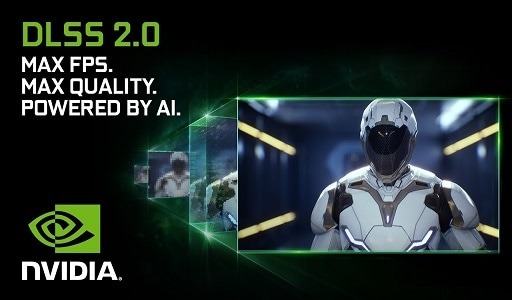Nvidia’s RTX 30-series and RTX 40-series graphics cards have two standout features: ray tracing and Nvidia RTX DLSS. The PlayStation 5 and Xbox Series X did an excellent job of introducing most people to ray tracing, but DLSS remains a little hazy.
It’s a little complicated, but it allows you to play a game at a virtualized higher resolution, maintaining greater detail and higher frame rates while putting less strain on your graphics card.
It combines the best of both worlds by leveraging the power of machine learning, and with the addition of DLSS 3, the technology has just become even more powerful.
But the story is a little more complicated than that. This article will teach you everything you need to know about DLSS, how it works, and what it can do for your PC games.

What is DLSS?
Deep learning super sampling is abbreviated as DLSS. The “super sampling” bit refers to an anti-aliasing technique that smooths out jagged edges on rendered graphics.
SSAA (supersampling anti-aliasing) works differently than other types of anti-aliasing because it renders the image at a much higher resolution and then uses that data to fill in the gaps at the native resolution.
Nvidia’s secret sauce is the “deep learning” component. Nvidia can train AI models with high-resolution scans by leveraging the power of machine learning. The anti-aliasing method can then use the AI model to fill in the gaps.
This is significant because SSAA often requires you to render the higher-resolution image locally. Nvidia does it offline, away from your computer, allowing you to reap the benefits of supersampling without the computational overhead.
This is all made possible by Nvidia’s Tensor cores, which are only found in RTX GPUs (outside of data center solutions, such as the Nvidia A100).
Although Tensor cores are present in the RTX 20 series GPUs, the RTX 3060, 3060 Ti, 3070, 3080, and 3090 feature Nvidia’s second-generation Tensor cores, which provide better per-core performance.
Nvidia’s latest RTX 40-Series graphics cards bring the Tensor cores to their fourth generation. This amplifies the DLSS boost even more. The cores’ throughput has increased by up to five times over the previous generation thanks to the new 8-bit floating point tensor engine.
Nvidia is currently leading the charge in this area, though AMD’s new FidelityFX Super Resolution feature may offer some stiff competition. Intel’s own super sampling technology, Intel XeSS, or Intel Xe Super Sampling, will be available soon. More on that in a moment.
You can also read: Nvidia New RTX 3080 with 12GB of Memory
What exactly does DLSS do?
DLSS is the result of a lengthy process of teaching Nvidia’s AI algorithm to create more visually appealing games. After rendering the game at a lower resolution, DLSS infers information from its super-resolution image training knowledge base to generate an image that appears to be running at a higher resolution.
The goal is to make 1440p games look like they’re running at 4K, or 1080p games look like 1440p. DLSS 2.0 provides four times the resolution, allowing you to render games in 1080p and output them in 4K.
Traditional super-resolution techniques can produce artifacts and bugs in the final image, but DLSS is designed to work around these flaws to produce an even better-looking image.
It can deliver significant performance boosts in the right circumstances without affecting the look and feel of a game; in fact, it can make the game look even better.
Whereas early DLSS games like Final Fantasy XV delivered modest frame rate improvements ranging from 5 to 15 frames per second, more recent releases have seen far greater gains. Nvidia introduced a new AI engine for DLSS with games like Deliver Us the Moon and Wolfenstein:
Youngblood, which we’re told improves image quality, especially at lower resolutions like 1080p, and can increase frame rates by more than 50% in some cases.
The frame rate gains from the latest iteration of DLSS 3 may be even greater. Nvidia demonstrated a video of Microsoft Flight Simulator with frame rates increased from 64 fps without DLSS to 135 fps with DLSS 3.
There are also new quality adjustment modes for DLSS users to choose from, with each focusing the Tensor core horsepower of the RTX GPU on a different aspect of DLSS.
You can also read: Nvidia GeForce Experience: Key Features and Benefits
How does DLSS work?
DLSS forces a game to render at a lower resolution (typically 1440p) and then uses its trained AI algorithm to infer what the game would look like if rendered at a higher resolution (typically 4K).
It accomplishes this through the use of anti-aliasing effects (likely Nvidia’s own TAA) and automated sharpening. Visual artifacts that would not be present at higher resolutions are also removed, and the details that should be present in an image are inferred.
According to Eurogamer, the AI algorithm is trained to look at specific games at extremely high resolutions (allegedly 64x supersampling) and is then distilled down to a few megabytes before being added to the latest Nvidia driver releases and made available to gamers all over the world. Initially, Nvidia had to go through this process game by game.
Nvidia provides a general solution in DLSS 2.0, so the AI model no longer needs to be trained for each game.
In essence, DLSS is a real-time version of Nvidia’s Ansel technology, which improves screenshots. It renders the image at a lower resolution to improve performance, then applies various effects to produce an overall effect that is comparable to increasing the resolution.
The end result can be mixed, but in general, it leads to faster frame rates without sacrificing visual fidelity. Nvidia claims that using both Nvidia RTX DLSS and ray tracing can improve frame rates by up to 75% in Remedy Entertainment’s Control.
It’s usually less pronounced than that, and not everyone likes the final look of a DLSS game, but the option is there for those who want to beautify their games without incurring the cost of running at a higher resolution.
At 1440p, we saw significant improvements over native rendering in Death Stranding. The finer details on the back package were lost in performance mode, particularly on the tape.
Quality mode preserved most of the detail while smoothing out some of the native render’s rough edges. The quality is shown without anti-aliasing in our “DLSS off” screenshot. Although Nvidia RTX DLSS does not achieve that level of quality, it is very effective at combating aliasing while retaining the majority of the detail.
We didn’t notice any over-sharpening in Death Stranding, but it’s something you might notice if you use DLSS.
What to expect from Nvidia RTX DLSS
DLSS has the potential to enable gamers who are unable to achieve comfortable frame rates at resolutions above 1080p to do so with inference.
DLSS is without a doubt one of the most potent features of the RTX GPUs. They aren’t as powerful as we had hoped, and while the ray-tracing effects are beautiful, they have a significant impact on performance, but Nvidia RTX DLSS gives us the best of both worlds: better-looking games that also perform better.
DLSS appeared to be a niche feature for low-end graphics cards at first, but that is no longer the case. Instead, DLSS has allowed games like Cyberpunk 2077 and Control to push visual fidelity on high-end hardware while remaining playable. DLSS improves low-end hardware while predicting the future of high-end hardware.
Nvidia demonstrated the RTX 3090 rendering games such as Wolfenstein: Youngblood at 8K with ray tracing and DLSS enabled. Although widespread adoption of 8K is still a long way off, 4K displays are becoming more common.
Instead of rendering at native 4K and hoping to maintain a frame rate of 50 to 60 frames per second, gamers can render at 1080p or 1440p and use DLSS to fill in the gaps. As a result, frame rates can be increased without sacrificing image quality.
DLSS is also constantly improving, and it receives regular updates in an effort to improve the AI algorithm. It can now make better use of motion vectors, which helps to improve how objects appear when they move.
The update also reduces ghosting, improves the clarity of particle effects, and improves temporal stability. DLSS 2 is now widely used, with 216 games supporting it as of September 2022.
However, the advancements do not stop there. In fact, with the introduction of DLSS 3, things are about to get a lot more interesting.
You can also read: NVIDIA Drivers: Things To Do After Installation
DLSS 3 reimagines technology by rendering frames rather than pixels.
Nvidia announced DLSS 3—the latest iteration of the technology that will be available to owners of RTX 40-series graphics cards—during its GTC 2022 keynote on September 20. Unlike some of the previous, smaller updates, the changes to DLSS this time are significant, and they have the potential to provide a significant increase in performance.
This time, DLSS will be able to predict actual frames rather than just pixels, filling in the gaps left by your GPU and providing a frame rate boost in many games.
According to Nvidia, DLSS 3 will be up to four times faster than DLSS 2, and it will be capable of improving the performance of most games, including those that rely primarily on the CPU rather than the GPU.
With this generation of its supersampling technology, Nvidia is going all-in on upgrades. The new optical flow accelerator aids DLSS in forecasting and filling in the blanks. Nvidia Reflex, a feature that synchronizes the GPU and the CPU, and reduces latency by up to two times, is also being introduced by the company.
As previously stated, Nvidia demonstrated DLSS 3 in Microsoft Flight Simulator, and the gains were significant — hitting 135 fps on this type of game, up from 64, is nothing short of massive. The gains in Cyberpunk 2077 were also substantial.
Overall, Nvidia CEO Jensen Huang promised that DLSS 3 will outperform DLSS 2 by up to four times. We’ll have to wait for the technology to be released before we can test it ourselves, which won’t happen until at least October 12.
You can also read: Best Cheap Gaming PC
Nvidia RTX DLSS vs FSR, RSR, XeSS
When it comes to graphics technology, AMD is Nvidia’s main rival. AMD released FidelityFX Super Resolution (FSR) in 2021 to compete with DLSS.
Although it achieves the same goal of improving visuals while increasing frame rates as DLSS, FSR operates in a very different manner. FSR renders frames at a lower resolution and then uses an open-source spatial upscaling algorithm to make the game appear to run at a higher resolution; it does not take motion vector data into account.
To achieve the same results, DLSS employs an AI algorithm, but this technique is only supported by Nvidia’s own RTX GPUs. FSR, on the other hand, can run on almost any GPU.
In addition to FSR, AMD offers Radeon Super Resolution (RSR), a spatial upscaling technique that employs AI. While this appears to be similar to DLSS, there are some differences.
RSR is a driver-based feature delivered by AMD’s Adrenalin software that uses the same algorithm as FidelityFX Super Resolution (FSR). RSR aims to fill the void left by FSR, which must be implemented directly into specific games. RSR should work in almost any game because it does not require developers to implement it.
Notably, FSR is supported by newer Nvidia and AMD GPUs, whereas RSR is only supported by AMD’s RDNA cards, which include the Radeon RX 5000 and RX 6000 series. RDNA 3 and its Radeon RX 7000 series GPUs will be added to the lineup soon.
Intel has also been developing its own super sampling technology known as Intel XeSS (Intel Xe Super Sampling). This image upscaling technology employs both spatial and temporal data, i.e., image and motion data, and leverages AI to improve image quality even further.
It uses machine learning and AI to improve image quality, similar to DLSS, by passing the data through a trained neural network.
Intel is developing two versions of XeSS. The first employs the XMX matrix math units, which will be found in its new Xe-HPG GPUs, to handle all AI processing on the hardware side. The other version will use the widely used four-element vector dot product (DP4a) instruction, eliminating the need for Intel’s own hardware.
According to Intel, Intel XeSS will provide a two-fold performance boost, while systems with slower hardware limited to 1080p resolution and low settings will be able to run games at 4K. Intel also intends to make the XeSS SDK and tools open-source.
Would you like to read more about Nvidia RTX DLSS-related articles? If so, we invite you to take a look at our other tech topics before you leave!










